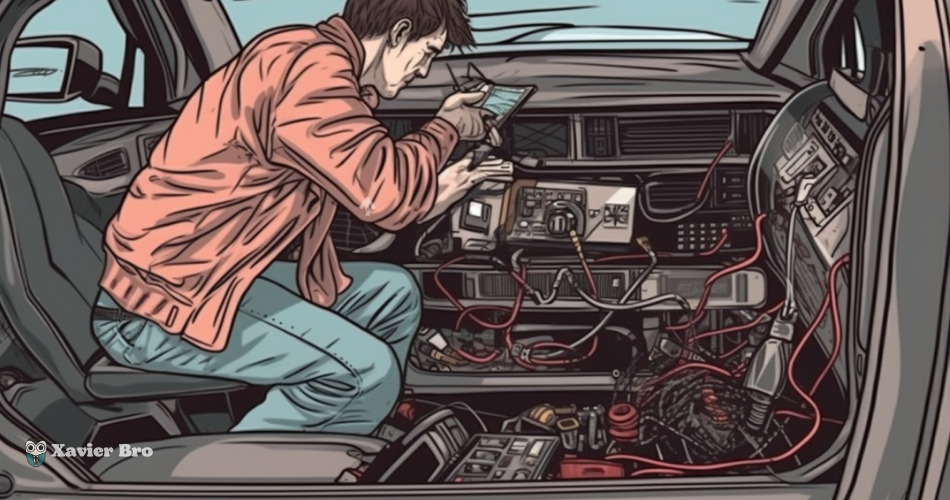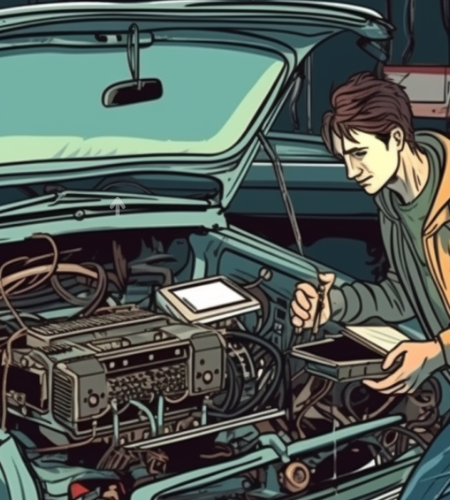Has your car’s computer been acting up lately? Strange engine sounds, jerky transmission shifts, or constant check engine lights may indicate it’s time to reset your vehicle’s brain. The powertrain control module and engine control unit are complex computers in modern cars. They can get slowed down over time. Unplugging and then plugging back the battery can restart the car’s computer. It gets the car working right again. But how long should you leave the battery disconnected to reset a car computer?
This article will look at the optimal time to clear error codes, erase stored data, and get your car’s computer working again.
Key Takeaways:
- Resetting the computer can fix performance issues from sensor errors and too many codes.
- Leave the battery unplugged for a full day or overnight to reset fully. It is enough time.
- Before disconnecting, turn off anti-theft and other electronics using the battery.
- After reconnecting the battery, let the car sit 30 minutes before starting. It lets systems reset.
- Don’t reset the computer a lot without a reason. It can erase helpful adjustments that optimize performance.
How Long to Leave Battery Disconnected to Reset Car Computer?
Most mechanics say to leave your car battery unplugged for at least 8 to 12 hours when resetting the car’s computer. It gives time for the computer’s memory to erase. Try to leave the battery unplugged overnight. Or for about 24 hours if you can.
Some cars may need the battery unplugged for 2 or 3 days to reset the computer. Check your car’s manual. Or ask a dealership mechanic to know the reset time for your car model.
If you leave the battery disconnected to reset car computer for less than 4 to 6 hours, it may give you less time for complete reset. It means stored codes and data may not clear out properly.
After plugging the battery back in, check the dash lights and error codes. It confirms that the computer reset worked fully.
Step-by-Step Process for Disconnecting Battery
Follow these simple steps to disconnect your car’s battery:
- Turn off all electronics like lights, audio systems, charging devices, etc. It prevents damage when the power is disconnected.
- Make sure your anti-theft code is accessible, as disconnecting battery power may erase saved codes. You’ll need to enter the code when reconnecting.
- Use the proper-size wrench to loosen the clamp holding the negative battery cable in place. Take care not to touch any tools to the positive terminal.
- Detach the negative battery cable entirely from the negative terminal post.
- Wait at least 8 hours or overnight before reconnecting the battery. Twenty-four hours is ideal for a full reset.
- To reconnect, attach the negative cable back onto the negative terminal securely.
- Let the vehicle sit for 30 minutes before starting the engine. It allows the computer to reboot sensors and systems.
- Enter anti-theft code if required and program radio presets once back in the driver seat.
- Drive as normal. The PCM will recalibrate settings as you drive.
Why Reset Your Car’s Computer?
You may want to reset your car’s computer by unplugging the battery for some good reasons. Resetting can clear any check engine check light error codes. It gives you a fresh start to recheck issues.

A reset can recalibrate sensors and components if your car is stalling or having shifting problems. It also erases any old data that has gotten out of sync, like temperature readings and fuel data. Resetting lets you start fresh with new settings. Unplugging and replugging the battery can also recharge it to full power.
However, you don’t need to reset the computer too much without a reason. Only reset when fixing a specific issue, not regularly.
Can a Weak Battery Cause Computer Problems?
A car battery that is low on power can cause problems with the vehicle’s computer. If the battery power is low, error codes may not clear fully after resetting. Sensors and modules might not get enough electricity to work right. It can make the engine stall or transmission shift weird.
The computer also may not reboot when reconnecting the low battery. Settings like the clock, radio stations, and fuel adjustments might not save or could erase. So before unplugging to reset, test if the battery has a full charge. Try charging it fully first.
A weak battery should be checked and replaced if needed. Having enough battery power helps the reset work best.
Does Disconnecting the Battery Reset Check Engine Light?
The check engine light on your dashboard is controlled by the powertrain control module (PCM). When an emissions-related error is detected, the PCM stores a diagnostic trouble code (DTC) and lights up the check engine lamp. Disconnecting and reconnecting the battery can reset these codes and turn the check engine light off.
However, if the underlying condition that caused the code is not addressed, the check engine light will turn back on the next time the car’s self-diagnostic system detects an error.
So while disconnecting the battery provides a temporary reset, other repairs may be needed to resolve the root problem. Diagnose trouble codes first before just resetting the light.
Other Ways to Reset Your Car’s Computer
Besides unplugging the battery, there are other ways to reset your car’s computer and error codes. You can plug in a scan tool that tells the computer to reset and clear codes.
Some vehicles have a backup power reserve even when the battery is unplugged. Removing a fuse can drain this extra power.
You can also turn the ignition on, then unplug the battery before fully turning off the car to reset it. And if you fix the actual sensor or mechanical problem causing a code, the computer will reset after it no longer detects the issue.
So along with battery disconnecting, those are other methods to reset your car’s brain and turn the check engine light off.
Crazy Facts
- The first car engine computers used analog components and appeared in the late 1960s. Modern digital engine computers first appeared in the early 1980s.
- A car’s engine control unit (ECU) conducts millions of calculations per second to monitor and adjust engine systems.
- Disconnecting the battery too quickly while the engine is still running can fry the car’s computer due to voltage spikes.
- Early ECUs had only about 2 KB of memory. Today’s powertrain control modules have over 100 MB of reprogrammable flash memory.
- The check engine light was introduced in the 1980s. Before then, diagnosing problems required using an external scan tool.
The Bottom Line
Unplugging and replugging your car’s battery is an excellent way to reset the computer and improve engine and transmission performance. It also clears any check engine light codes. Leave the battery disconnected to reset car computer for at least 24 hours or overnight. Just take safety precautions and follow the steps to reconnect correctly.
Resetting the computer can keep your car running optimally. But only do it sometimes. Frequent resets also erase helpful settings that improve driving over time. It’s best only to reset when fixing a specific engine or performance problem, not regularly.
FAQs about How Long to Leave Battery Disconnected to Reset Car Computer
How do I know if my car’s computer needs to be reset?
Signs like check engine lights, performance issues, sensor errors, or erratic transmission shifting could mean your car computer needs a reset. Strange engine sounds or sluggish throttle response is another clue.
Can disconnecting the battery delete my car’s programmed keys?
On some makes/models, it can erase programmed keys. You may need to reprogram or relearn key codes after a battery reset.
Will a reset clear the “adaptive memory” learned by my car?
Yes, resetting typically clears any learned adjustments to fuel trim, transmission shifting, throttle response, etc. The car will relearn these optimizations over time through driving.
I hope you enjoy our article, do check out more of our amazing articles.

Thanks for finally talking about > How Long to Leave
Battery Disconnected to Reset Car Computer? – Xavier
Bro < Liked it!